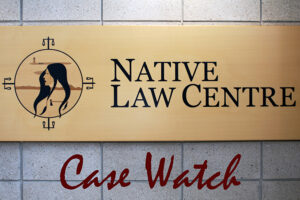Ontario’s motion is dismissed. Ontario moved for an Order to strike out Iskatewizaagegan’s Amended Statement of Claim claiming that it is plain and obvious that Iskatewizaagegan pleading disclosed no reasonable cause of action for breach of a sui generis or an ad hoc fiduciary duty. The Court finds that it is not plain and obvious that Iskatewizaagegan does not have a tenable cause of action based on a sui generis fiduciary duty or an ad hoc fiduciary duty.
The City of Winnipeg, Manitoba [“Winnipeg”] extracts its drinking water from Shoal Lake, which is located predominantly in Ontario, but also Manitoba. Shoal Lake has been extracted for this purpose for over 100 years but has not paid anything to the Plaintiff, the Iskatewizaagegan No. 39 Independent First Nation [“Iskatewizaagegan”]. Winnipeg is being sued by Iskatewizaagegan for compensation for injurious affection, with damages claimed at $500 million. Iskatewizaagegan also sues the Province of Ontario, for breach of fiduciary duty.
Iskatewizaagegan pleads two distinct theories of Crown liability for breach of fiduciary duty: 1) a sui generis fiduciary duty based on the relationship between Aboriginal peoples and the Crown; and 2) an ad hoc fiduciary duty. It relies on a 1913 Order in Council along with antecedent Royal Proclamations and Treaties and sequent legislation enacted by Ontario.
In this matter, Ontario moves for an Order to strike out Iskatewizaagegan’s Amended Statement of Claim without leave to amend and to dismiss the action for failing to disclose a reasonable cause of action. Ontario states that it is plain and obvious that Iskatewizaagegan pleading discloses no reasonable cause of action for breach of a sui generis or an ad hoc fiduciary duty. Ontario’s action is dismissed.
The people of Iskatewizaagegan are Anishinaabe. They are a distinct Aboriginal society, a recognized Band under the Indian Act, and an Aboriginal people within the meaning of s 35 of the Constitution Act, 1982. Shoal Lake is a part of the cultural identity of Iskatewizaagegan and its people. Since time immemorial, the Anishinaabe have used the waters of Shoal Lake and the surrounding land for survival. Iskatewizaagegan’s culture is coextensive with Shoal Lake and the surrounding land. The transmission of Anishinaabe teachings, traditions, and values to future generations takes place and continues to take place at Shoal Lake.
Common law real property concepts do not apply to Aboriginal lands or to reserves. Aboriginal title and interest in reserves are communal sui generis interests in land that are rights of use and occupation that are distinct from common law proprietary interests. An Aboriginal interest in land will generally have an important cultural component that reflects the relationship between an Aboriginal community and the land. The Aboriginal interest in land is a sui generis independent beneficial legal ownership interest that burdens the Crown’s underlying title, which is not a beneficial ownership interest and which may rather give rise to a fiduciary duty on the part of the Crown.
Iskatewizaagegan is a beneficiary of the Royal Proclamation of 1763, and was ratified by assembled Indigenous Nations by the Treaty of Niagara 1764. In the summer of 1764, representatives of the Crown and approximately 24 First Nations, met at Niagara. The lengthy discussions lead to the Treaty of Niagara 1764, which was recorded in wampum. The Crown does not recognize the Treaty of Niagara 1764 as substantively altering the legal effects of the Royal Proclamation of 1763. In contrast, First Nations assert that the Royal Proclamation of 1763 must be understood together with the Treaty of Niagara 1764 and so understood the Royal Proclamation of 1763 constitutes a recognition of Indigenous sovereignty.
In 1873, Iskatewizaagegan entered into Treaty No 3 with the Crown. The reserve of Iskatewizaagegan No. 39 adjacent to Shoal Lake was established pursuant to Treaty No 3. Treaty No 3 is a pre-confederation treaty on behalf of the Dominion of Canada and Chiefs of the Ojibway. The Ojibway yielded ownership of their territory, except for certain lands reserved to them. In return, the Ojibway received annuity payments, goods, and the right to harvest the non-reserve lands surrendered by them until such time as they were taken up for settlement, mining, lumbering, or other purposes by the Government of the Dominion of Canada. Although Treaty No 3 was negotiated with the Crown in right of Canada, the promises made in Treaty No 3 are promises of the Crown. The federal Government and Ontario are responsible for fulfilling the promises of Treaty No 3 when acting within the division of powers under the Constitution Act, 1867.
In exercising its jurisdiction over Treaty No 3 lands, Ontario is bound by the duties attendant on the Crown and it must exercise its powers in conformity with the honour of the Crown and the fiduciary duties that lie on the Crown in dealing with Aboriginal interests. The honour of the Crown has been a principle animating Crown conduct since at least the Royal Proclamation of 1763, through which the British asserted sovereignty over what is now Canada and assumed de facto control over land and resources previously in the control of Aboriginal peoples. The categorical fiduciary duty owed by the Crown in the Aboriginal context is sui generis. From the honour of the Crown and the Federal Government’s exclusive jurisdiction in respect of Indians under s 91(24) of the Constitution Act, 1867, the Crown has the responsibility to act in a fiduciary capacity with respect to Aboriginal peoples.





